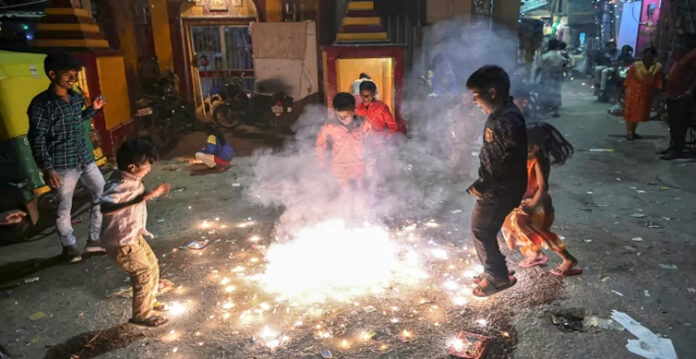Hyderabad’s air quality plunged to “hazardous” levels on Thursday night (October 31) as revelers across the city celebrated Deepavali, bursting firecrackers well beyond the 10 p.m. deadline set by local authorities. A surge in particulate matter levels highlighted the detrimental impact of the festive fireworks, which filled the night air with pollutants, setting off alarms for public health.
Despite restrictions enforced by the Hyderabad Police on cracker bursting, the limit was largely ignored as the city sky was lit up by aerial pyrotechnics. According to the U.S. Consulate’s observatory, the PM2.5 concentration—a measure of fine particulate matter that can penetrate deep into the lungs—soared to a high of 475 µg/m³. In the Kapra neighborhood, it spiked to 454 µg/m³, and at the Sanathnagar station, which resumed monitoring shortly after midnight, it peaked at 472 µg/m³. These readings place Hyderabad’s air quality in the hazardous category, significantly surpassing the recommended safe levels of PM2.5.
Notably, PM10 levels, which track slightly larger particulate matter, also reached extreme heights. Ramachandrapuram, a suburb on Hyderabad’s outskirts, recorded a PM10 level of 605 µg/m³, contributing to the declining air quality.
Also Read: Bursting firecrackers on Diwali leads to spike in air pollution in Chennai
Compounding the issue, five of the Central Pollution Control Board’s (CPCB) real-time air monitoring stations experienced technical outages at the worst possible time, from 10 p.m. until 1 a.m., at Zoo Park, Bollarum, Patancheru, Somajiguda, and Sanathnagar. This left a crucial gap in data collection as pollution levels were peaking. Although Sanathnagar station eventually came back online, showing PM2.5 at 472 µg/m³, it recorded no data during the peak contamination hours between 10 p.m. and 1 a.m., capturing only other parameters such as nitrogen dioxide, sulfur dioxide, carbon monoxide, and ozone.
In 2022, the Sanathnagar station was the sole functioning monitoring site during Deepavali and recorded an even more alarming PM2.5 level of 759 µg/m³ at 10 p.m. on October 24. Although improvements in monitoring infrastructure were anticipated, the outages this year point to ongoing challenges in managing real-time data during air quality crises.
Experts have long warned that exposure to elevated PM2.5 and PM10 levels can have severe health repercussions, particularly for vulnerable populations such as children, the elderly, and individuals with respiratory conditions. PM2.5 particles, which are less than 2.5 micrometers in diameter, can penetrate the lungs and enter the bloodstream, exacerbating asthma, heart disease, and other chronic health conditions.
Authorities are expected to take additional preventive measures to control pollution in the future. Hyderabad’s civic bodies have already initiated public awareness campaigns highlighting the health risks of firecracker pollution. With the continued reliance on traditional celebrations involving fireworks.
As Hyderabad recovers from yet another spike in pollution, environmentalists and health officials are likely to call for tougher enforcement of air quality guidelines to protect public health during festival seasons. The hazardous levels recorded this year underline the urgent need for a coordinated approach to address festive pollution in India’s rapidly urbanizing cities.
(This story is sourced from a third-party syndicated feed. Raavi Media takes no responsibility or liability of any nature. Raavi Media management/ythisnews.com can alter or delete the content without notice for any reason.)


